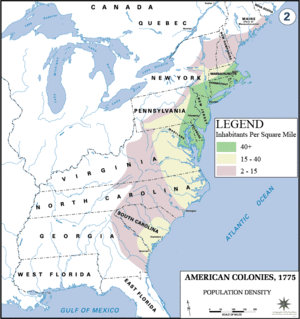Westervelt massacre
| Westervelt massacre | |
|---|---|
_black-and-white.jpg) The Westervelt massacre occurred approximately 12 miles southeast of Low Dutch Station on the way to Harrod's Town. The settlements appear on Filsom's 1784 map of the County of Kentucke, Virginia. | |
| Location | Floyd's Fork and Broad Run, Kentucky |
| Date |
June 27, 1780 3:00 am – |
Attack type | Mass murder |
| Deaths | 17 killed |
The Westervelt massacre (also known as the Westerfield massacre) was an indigenous attack on a caravan of Dutch frontier settlers that occurred during the American Revolutionary War around 3:00 am on June 27, 1780 in Kentucky County, Virginia.[1] The settlers were traveling southeast from Low Dutch Station to Harrod's Town. The settler relocation was in part a reaction to British Captain Henry Bird's invasion of Kentucky. The area immediately east of Low Dutch Station had been overrun with British allied Indians. Harrod's Town was fortified and a move south would lead the settlers away from Captain Bird's invading army from the north. The caravan was ambushed in a surprise attack, during the night, after a day's travel of twelve miles. The exact location of the massacre is not definitively known. However, it is likely to have occurred at Floyd's Fork and Broad Run.[1] The caravan was formed by Jacobus Westervelt and consisted of forty-one settlers from ten different families. Ten of the seventeen settlers killed were members of the Westervelt family.[1] The victims included men, women, and children. The Indians responsible for the massacre were allied to the British and received ₤5 for each victim's scalp cut off and returned to the British authorities.[1] The Indians were thus awarded ₤85 by the British for massacring the Dutch settlers. The Westervelt Massacre had a chilling effect on the region. A number of settlers from Low Dutch Station joined Colonel George Rogers Clark's militia after the massacre.
Historical background

Following the Second Virginia Charter in 1609, the territory claimed by the English Colony of Virginia was expanded to cover the modern US state of Kentucky. However, the areas claimed by Virginia were in name only and would not be officially explored by the British until 1750. A scouting party, led by Dr. Thomas Walker, returned with reports of indigenous activities, topographical surveys, and botanical research. During the expedition, the first house was also built in Kentucky. However, Walker and his scouting party returned to the colonies. The area would not be permanently settled by Westerners until 1775, during the beginning stages of the American Revolutionary War.
In 1780, Hendrick Banta led a large contingent of Dutch from Pennsylvania into Kentucky, where they began the settlement of Low Dutch Station along Beargrass Creek.In the spring of 1780, Dutchman Jacobus Westervelt and his family arrived in Kentucky County, Virginia. They were among the earliest wave of frontier settlers.[1] The Westervelts were one of the founding families of the Low Dutch Station settlement.[1] However, by the summer of 1780, the Westervelt family prepared to move to Harrod's Town, Kentucky. The region was becoming increasingly dangerous with Indian raids. Likewise, the British invasion of 750 men from the Province of Quebec, led by Captain Henry Bird, resulted in many settlers seeking safer territory. The British army crossed into Kentucky on May 25, 1780. On June 21, 1780, Jacobus Westervelt purchased 400 acres of land in the area of Harrod's Town. Shortly thereafter, Jacobus Westervelt hired John Thixton as a guide for the caravan. The Dutch families gathered in Low Dutch station the following weekend, setting out on June 26, 1780.
The massacre
First account testimonies of the Westervelt massacre were preserved in the manuscripts of Lyman C. Draper in 1865. According to the reports, the caravan camped by running water approximately twelve miles from Low Dutch Station.[2] The families that were traveling included the Westervelts, Swans, McGlaughlins, Plyburns, and Thixtons. In the darkness of early morning, the settlers were awakened to the sounds of carnage.
As historian Ronald Belcher wrote:
Survivors from the attack recounted hearing hacking sounds, chopping, "crackling of skulls, plundering and screaming", joined by the sound of volleys discharged from muskets. In moments, about half the members of the Westervelt group were slaughtered despite valiant attempts by the men to protect the women and children. Fewer than half of the approximately forty settlers managed to escape.[1]
The majority of the men were killed within minutes.[3] The only men that managed to escape were the frontier guides: John Thixton, William Thixton, and Thomas Pearce. Several of the wives and children were also killed, while others were taken prisoner.
See also
- American Revolutionary War
- Captain Henry Bird's military invasion of Kentucky
- George Rogers Clark
- Historical list of Indian massacres
- Kentucky County, Virginia
- Low Dutch Station
References
- 1 2 3 4 5 6 7 Ronald Clay Belcher, Westervelt Massacre in Kentucky in 1780. Blue Grass Roots. Quarterly Journal of the Kentucky Genealogical Society. Frankfurt, Kentucky. Vol. 38, No. 2: 2011. pp. 30-37.
- ↑ Lyman C. Draper. The Draper Manuscript, Boone Papers, Series C, Vol. 24: 1865. p. 145.
- ↑ Lyman C. Draper. The Draper Manuscript, Kentucky Papers, Series CC, Vol. 13: 1865. pp. 11-12.
External links
- Westerfield Massacre Bullitt County Museum